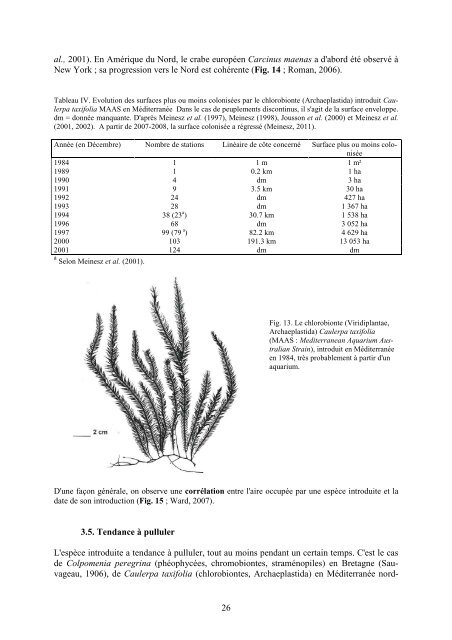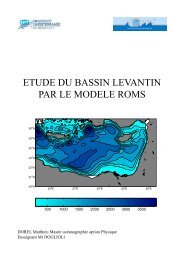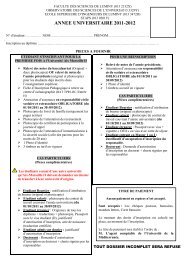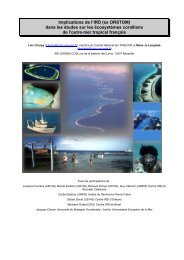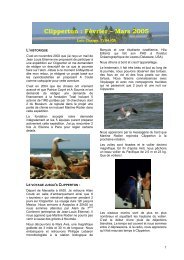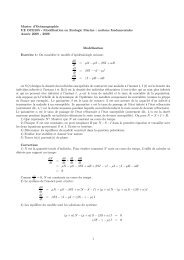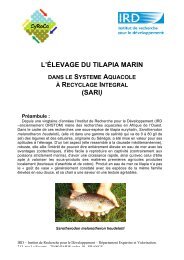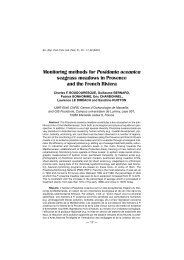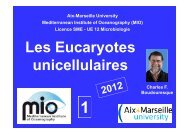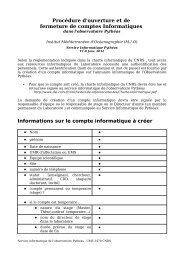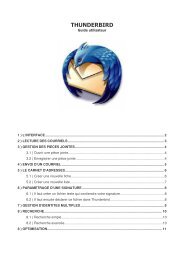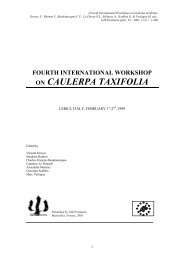- Page 1 and 2: Les invasions et transferts biologi
- Page 3 and 4: SOMMAIRE 1. Introduction ..........
- Page 5 and 6: 1. Introduction On désigne sous le
- Page 7 and 8: dracea) (chlorobiontes, Archaeplast
- Page 9 and 10: fait, celà s'explique au moins en
- Page 11 and 12: Les espèces vagabondes 6 sont des
- Page 13 and 14: esque et Verlaque, 2012). C'est l'h
- Page 15 and 16: et al., 2000 ; Occhipinti et Galil,
- Page 17 and 18: auparavant 20 (Petersen et al., 199
- Page 19 and 20: 2005) et désignent sous le nom d'a
- Page 21 and 22: La problématique de ces transferts
- Page 23 and 24: du WNV (West Nile Virus), qui affec
- Page 25: diterranée, après sa découverte
- Page 29 and 30: Fig. 17. Carte de répartition du m
- Page 31 and 32: seulement un dans l'Atlantique Nord
- Page 33 and 34: en provenance de diverses régions
- Page 35 and 36: Chez des espèces anciennement intr
- Page 37 and 38: 3.10. Validité de ces critères Le
- Page 39 and 40: atlantiques de l'Amérique du Nord,
- Page 41 and 42: 4.2. Les do-gooders En anglais, do-
- Page 43 and 44: transports d'huîtres ou de naissai
- Page 45 and 46: Fig. 27. Capacité d'eau de ballast
- Page 47 and 48: Les eaux de ballast transportent é
- Page 49 and 50: chée à l'ancre ou piégée dans l
- Page 51 and 52: esque, 1996 ; Boudouresque et Verla
- Page 53 and 54: 2009 à Nice (Por, 2009 ; Noël et
- Page 55 and 56: souches introduites et l'évasion d
- Page 57 and 58: Si les exemples connus d'hybridatio
- Page 59 and 60: douresque et Verlaque, 2002b, 2010,
- Page 61 and 62: égion donneuse, qui fonctionne alo
- Page 63 and 64: la diversité spécifique élevée
- Page 65 and 66: En fait, l’effet positif de la di
- Page 67 and 68: serait limité ; quand il est élev
- Page 69 and 70: aussi bien natives qu'introduites (
- Page 71 and 72: tosoides profite des clairières (n
- Page 73 and 74: Crawley, 1986 ; Newsome et Noble, 1
- Page 75 and 76: Amérique, Nouvelle Zélande et Aus
- Page 77 and 78:
(Schlaepfer et al., 2005). Naturell
- Page 79 and 80:
gion d'origine ; Clay, 2003), mais
- Page 81 and 82:
phytes introduites (depuis le débu
- Page 83 and 84:
Seule l'ouverture simultanée de to
- Page 85 and 86:
l’aquaculture, mais tout simpleme
- Page 87 and 88:
(par exemple, actuellement, le réc
- Page 89 and 90:
anipora membranacea en Nouvelle Ang
- Page 91 and 92:
s'est produite aux Baléares (Enric
- Page 93 and 94:
93 Fig. 50. Effectifs de moutons en
- Page 95 and 96:
2002 ; Shiganova et al., 2003 ; Shi
- Page 97 and 98:
Dans le domaine continental, un cas
- Page 99 and 100:
Grateloupia lanceolata 1982 V O J B
- Page 101 and 102:
En ce qui concerne les métazoaires
- Page 103 and 104:
nombre total d'espèces introduites
- Page 105 and 106:
- (2) L'absence de législation (ju
- Page 107 and 108:
Tableau XVII. Evolution du nombre d
- Page 109 and 110:
En réalité, le fait que la plupar
- Page 111 and 112:
habitats non perturbés ont une gra
- Page 113 and 114:
l'introduction du moustique Culex q
- Page 115 and 116:
fornicata (mollusque), lorsqu'elle
- Page 117 and 118:
dans le golfe de Gabès, en Tunisie
- Page 119 and 120:
Fig. 66. A gauche, les étapes du r
- Page 121 and 122:
tus et Genitocotyle nitocotyle medi
- Page 123 and 124:
Ecosystème A 500 espèces Ecosyst
- Page 125 and 126:
Caulerpataxifolia- Fig. 72. Changem
- Page 127 and 128:
diminuée de 21% chez les juvénile
- Page 129 and 130:
culement (regime shift) ) de l'éco
- Page 131 and 132:
131 Fig. 80. En Méditerranée orie
- Page 133 and 134:
menté de 50% et le taux de filtrat
- Page 135 and 136:
2005). En milieu continental égale
- Page 137 and 138:
introduit d'Amérique du Nord, abat
- Page 139 and 140:
Fig. 88. Aire de distribution effec
- Page 141 and 142:
Phylloxera en Europe occidentale (v
- Page 143 and 144:
Afrique du Sud, Inde et Brésil), l
- Page 145 and 146:
taines de milliers de tonnes à que
- Page 147 and 148:
Dans les Grands Lacs (Amérique du
- Page 149 and 150:
al., 2004), qui ne mettent pas en
- Page 151 and 152:
dustrielles (centrales thermiques,
- Page 153 and 154:
peut-être la cause réelle des ‘
- Page 155 and 156:
2007). Toutefois, les auteurs ne pr
- Page 157 and 158:
11. La prévention des introduction
- Page 159 and 160:
of Practice de la Commission europ
- Page 161 and 162:
l'introduction d'organismes génét
- Page 163 and 164:
En Allemagne, la Loi de Protection
- Page 165 and 166:
un gendarme devant le jardin de cha
- Page 167 and 168:
eaux avant le déballastage (Carlto
- Page 169 and 170:
cace quand les navires remplacent d
- Page 171 and 172:
Le fait que les espèces marines be
- Page 173 and 174:
lindracea), en Italie, l'arrachage
- Page 175 and 176:
La lutte chimique, au moyen d'herbi
- Page 177 and 178:
n'élimine pas l'espèce-cible : el
- Page 179 and 180:
1993 ; Caddy, 1994 ; Gesamp, 1997 ;
- Page 181 and 182:
vescens (arrachage, coupe des grand
- Page 183 and 184:
chis porphyriacus en Australie ; le
- Page 185 and 186:
185 Fig. 107. . Cet article est par
- Page 187 and 188:
espèces ; les perturbations peuven
- Page 189 and 190:
l’échelle des temps géologiques
- Page 191 and 192:
public et est donc également contr
- Page 193 and 194:
Références ABBOTT R.J., JAMES J.K
- Page 195 and 196:
BALLESTEROS E., GARRABOU J., HEREU
- Page 197 and 198:
BERNAUER D., JANSEN W., 2006. Recen
- Page 199 and 200:
BOUDOURESQUE C.F., 1994. Les espèc
- Page 201 and 202:
BUCCIARELLI G., GOLANI D., BERNARDI
- Page 203 and 204:
marine vegetation (Yasmine-Hammamet
- Page 205 and 206:
CLERGEAU P. , NUÑEZ M.A., 2006. Th
- Page 207 and 208:
CROOKS J.A., 2002. Characterizing e
- Page 209 and 210:
DICKMANN O.E., GOUVELA L., PEREZ J.
- Page 211 and 212:
FARNHAM W.F., 1980. Studies on alie
- Page 213 and 214:
FURLANI D.M., 1996. A guide to the
- Page 215 and 216:
GLOWKA L., DE KLEMM C. de, 1996. In
- Page 217 and 218:
HAMON D., 1996. Effets de la prolif
- Page 219 and 220:
HORTA P., OLIVEIRA E.C., 2000. Morp
- Page 221 and 222:
KAISER J., 2002. The science of Pfi
- Page 223 and 224:
KUSAKINA J., SNYDER M., KRISTIE D.N
- Page 225 and 226:
LOCKWOOD J.L., SIMBERLOFF D., McKIN
- Page 227 and 228:
MEINESZ A., 1992. Modes de dissémi
- Page 229 and 230:
MISTRI M., 2003. The non-indigenous
- Page 231 and 232:
OCCHIPINTI-AMBROGI A., 2002. Suscep
- Page 233 and 234:
PATTI F.P., GAMBI M.C., 2001. Phylo
- Page 235 and 236:
PROCACCINI G., RUGGIERO M.V., FAMA
- Page 237 and 238:
RODRIGUEZ-PRIETO C., 1997. Diffusio
- Page 239 and 240:
SCHAFFELKE B., SMITH J.E., HEWITT,
- Page 241 and 242:
SOLIGNAC M., CORNUET J.M., VAUTRIN
- Page 243 and 244:
THOMPSON J.D., 1991. The biology of
- Page 245 and 246:
VIARD F., 2010. Focus on the slippe
- Page 247 and 248:
WYATT T., CARLTON J.T., 2002. Phyto


